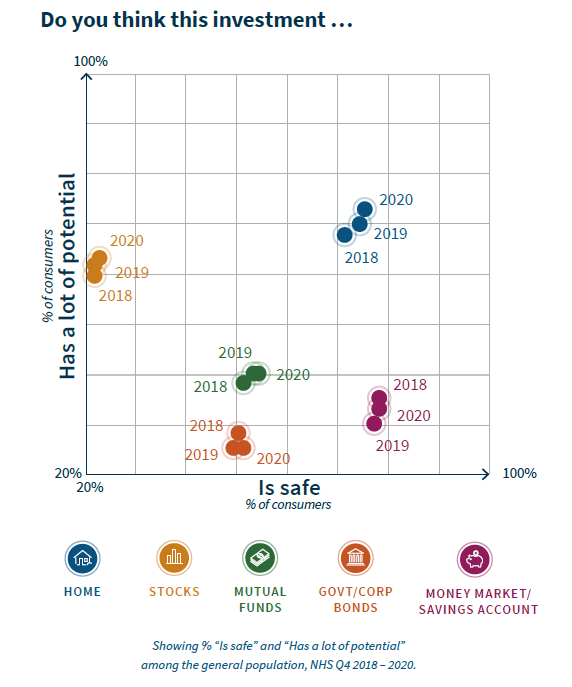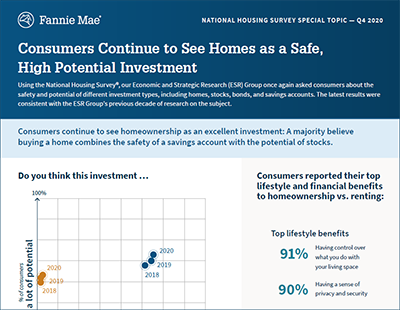Consumers Continue to See Housing as a Safe, High-Potential Investment
The single-family housing market was particularly strong in 2020. As of Q4 2020, home prices appreciated 10.8% year over year, according to the FHFA Home Price Index, and the National Association of Realtors reported that monthly sales of existing homes were more than 20% higher, year over year, in Q4 2020. We attribute much of housing's strength to the response of policymakers and consumers to the truly unique circumstances of the COVID-19 pandemic. Thus far, the pandemic has contributed to historically low mortgage rates, higher savings for many households, and even stronger demand for homes relative to supply, as many households searched for homes with additional features, including more space, home offices, and the ability to safely "nest" with their families. Even in the years prior to the pandemic, consumers reported that they believed housing, as an asset class, was a safe investment with high potential, a perception which, if it persists, will likely further support demand even as pandemic-related factors recede.
As part of our Q4 2020 National Housing Survey®, we again asked consumers about various investment types, including stocks, bonds, homes, and savings accounts. Seventy-five percent of respondents indicated that homes are a "safe" investment, ranking in safety just slightly below a savings/money market account. Additionally, 73% of consumers felt that investing in a home has "a lot of potential" – by comparison, 63% of consumers believe that stocks have "a lot of potential."
These numbers have remained relatively consistent over the last 10 years of NHS data collection, including during the pandemic. Americans appear to have an ingrained belief that housing investments are almost as safe as a money market or savings account, but also that they have the growth potential of a stock investment. Looking a little deeper, all demographic groups surveyed had a high, positive perception of housing as an investment, but there were slight differences; one is that Black and Hispanic consumers tend to have a slightly stronger belief that housing has a "a lot of potential" compared to White and Asian consumers. Meanwhile, White and Asian consumers tend to have a slightly stronger belief that housing is a "safe" investment compared to Black and Hispanic survey respondents.
We know that the perception of housing as a "safe" investment with "a lot of potential" does not necessarily align with reality. Housing prices can experience steep declines or fluctuations depending on the holding period (see FHFA Home Price Appreciation Chart since 1991); the timeline of when someone buys and sells their home is an important factor in the overall return. Additionally, transaction costs are generally higher for housing than other assets. However, when comparing homeownership to other investments, consumers may be factoring in the rent they may otherwise have to pay, and for some consumers the tax benefits of owning a home remain meaningful. Finally, the availability and extent to which consumers can leverage their down payment by purchasing a home, as opposed to placing those funds in alternate investments, such as a mutual fund or a savings account, is unique. One often overlooked feature of a fixed-rate self-amortizing mortgage is that it acts as a forced savings mechanism as the principal balance on the loan is gradually reduced by funds that would otherwise have gone to rent payments.
Holding period and other caveats aside, our latest survey reminds us that consumers remain focused on the long-term potential of housing. In fact, 85% of consumers in our survey believe homeownership leads to wealth-building and better financial health, numbers that have been consistent over time. There is support for that view in the literature. According to two studies in particular, Homeownership and the American Dream1 and The Rate of Return on Everything2, after "imputed rent" is included in a home's financial return (i.e., the rent one would have to pay if they did not own their home), the rate of return on owning a home has historically been similar to other asset classes such as stocks.3
Consumers also value homeownership for non-monetary reasons, with emotional and tangible aspects perhaps contributing to the opinion that owning a home is an investment with "a lot of potential." Generally speaking, this is something that other investments (e.g., stocks, bonds) or renting may not provide. Ninety percent of consumers say owning a home "gives a sense of privacy and security;" and 89% say it allows for "a good place to raise your family," compared to renting a home. The reasons may vary, but the experiential aspects of owning a home likely play a role in its high perceived value.
Owning a home is also considered by most to be part of "the good life," with survey data showing that 87% of consumers report that owning a home is important for "the good life." For context, other items ranking higher on "the good life" list included health, financial security, preferred living location, and work/life balance.
Consumers' assessment of the benefits of homeownership and their belief in a home as a solid investment have not changed much over the years, despite recent adverse events including the Great Recession and the current pandemic. While some may believe this stems from the American psyche of "individualism" and wanting to own personal property, it may also simply be a reasonable belief, given comparisons to other assets and the emotional, non-monetary benefits that clearly factor into homeownership perceptions. It may take a large increase in the relative returns of other asset classes, or fewer favorable financial incentives for homeownership, for consumer attitudes of housing as an investment to change. For now, we expect these longstanding beliefs in the benefits of homeownership to continue to provide demand-side support in the housing market.
The author thanks Michael Lacour-Little for valuable contributions in the creation of this commentary and the design of the research. Of course, all errors and omissions remain the responsibility of the author.
Opinions, analyses, estimates, forecasts, and other views of Fannie Mae's Economic and Strategic Research (ESR) Group included in these materials should not be construed as indicating Fannie Mae's business prospects or expected results, are based on a number of assumptions, and are subject to change without notice. How this information affects Fannie Mae will depend on many factors. Although the ESR group bases its opinions, analyses, estimates, forecasts, and other views on information it considers reliable, it does not guarantee that the information provided in these materials is accurate, current, or suitable for any particular purpose. Changes in the assumptions or the information underlying these views could produce materially different results. The analyses, opinions, estimates, forecasts, and other views published by the ESR group represent the views of that group as of the date indicated and do not necessarily represent the views of Fannie Mae or its management.
1 Home Ownership and the American Dream, Journal of Economic Perspectives—Volume 32, Number 1—Winter 2018—Pages 31–58, Laurie Goodman and Christopher Mayer
2 The Rate of Return on Everything, 1870-2015, Federal Reserve Bank of San Francisco Working Paper Series, Author(s): Oscar Jorda, Katharina Knoll, Dmitry Kuvshinov, Moritz Schularick, and Alan M. Taylor https://www.frbsf.org/economic-research/publications/working-papers/2017/25/
3 Home Ownership and the American Dream, Journal of Economic Perspectives—Volume 32, Number 1—Winter 2018—Pages 31–58, Laurie Goodman and Christopher Mayer, p. 13, "Our results suggest that there remain very compelling reasons for most American households to aspire to become homeowners. Financially, the returns to purchasing a home in a "normal" market are strong, typically outperforming the stock market and an index of publicly traded apartment companies on an after-tax basis. Of course, many caveats are associated with this analysis, including variability in the timing and location of the home purchase, and other risks and tradeoffs associated with homeownership."




